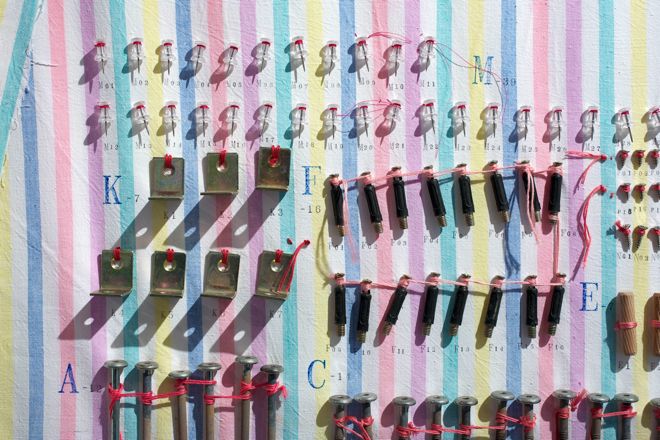Au Hoi Lam: My Father is Over the Ocean
Osage Shanghai (Room 101, Block 5, Wangzu City, 251 Caoxi Road, Xuhui District, Shanghai) March 14—May 30, 2014
One of China’s most interesting galleries in terms of showcasing Hong Kong talent, Osage has nonetheless a reputation for mysterious disappearing acts—opening and closing a number of spaces in relatively rapid succession across Asia. Since 2007, the gallery has had spaces in Beijing, Shanghai, Singapore and Hong Kong—including Kwun Tong, Osage Hong Kong and Osage Soho. After having two spaces in Shanghai, one on Duolun Road in 2007, which was replaced by a short-lived French concession space open from 2010-2011, the gallery has, after a three-year hiatus, reopened in Xuhui district. Osage’s mercurial presence was attributed in part to the departure of David Chan to Hong Kong, and finding it difficult to fill his shoes, the gallery sought to simply close their Shanghai location.
On March 14, Osage reopened with a new space on Caoxi Lu located, surprisingly, in a faux-neoclassical mixed-use compound along a dusty elevated highway. Inside, the space is surprisingly crisp—keeping up to white cube standards.
The building is refreshingly accessible by metro. It was chosen to the proximity to the offices of the textile business of the owner of Osage, Agnes Lin, and will primarily focus on residency projects with pan-Asian artists, curators and researchers living outside the Mainland.
The Hong Kong artist Au Hoi Lam was first to take part in the residency with her project “Au Hoi Lam: My Father is Over the Ocean. Shanghai Postscript.” Au was in some ways a fitting choice, as her project managed to intertwine selected personal memories relating to Shanghai—including “My Parents Bought Me a Blouse from Shanghai on the 4th of May 2001,” which was chronicled in diary and painting form—a gift by her parents which was bought in Shanghai.
Au’s family is the pivot point of this extremely personal show—a mixed media shrine to the loss of her father. A somewhat remote figured in her life who worked as a customs’ officer, Au’s father seems to signify not only a loss but a lost opportunity for intimacy—we see this spelled out on the planks of a bunk bed her father bought, in a series of questions she has for her father.
The show revolves around the central metaphor of water, which if we take this in a morbid direction can extend to the idea of a sea burial. There are numerous references to the song “My Bonnie Lies Over the Ocean,” words printed out on brown paper, then crossed out in black marker, pieces of paper colored in blue pencil crayon with the aforementioned words inscribed on them, a mattress, with sheets, studded with pearly tipped sewing pins spelling out the words “Bring Back,” and a light blue green stripe that extends the whole way around the gallery, representing a nautical horizon.
As a whole, the exhibition conveyed a very complete picture, which is at times quite moving (particularly the mattress “There are Some Pearls, pearl head pins, new printed cotton double and single bedding set, felt, used mattresses, 2012-2013”), but individually, the works seemed relatively mute—deriving most of their power from the back-story with which they are associated. Standing on their own, they are no doubt aiming at subtlety but the formal aspects could have benefited from further development. The work seemed in a sense not quite ready. Nonetheless, the show demonstrated the practice of a very focused artist with a strong personal vision. This is in keeping with the style and mission of the gallery, something which Shanghai has been lacking.

区凯琳,《我會一一照料好 》, 丙烯顏料、油性墨、印花棉床單碎布、棉繡花線、用過的碌架床之二百二十四粒零件, 尺寸不定, 2012-2013(圖片由藝術家及奧沙畫廊提供)

区凯琳,《爸爸,今天你看見怎樣的藍?》,鉛筆、木顏色、無酸紙(日記簿)、銅釘、水松板、膠片、木框,一組十三件,每件100 ×100 ×2.4, 2012-2013(图片由艺术家及奥沙画廊提供摄影:关尚智, Living Collection)

区凯琳,《那兒有些珍珠》珠針、全新雙人及單人棉印花寢具套裝、戟絨、用過的碌架床之兩張床墊,尺寸不定, 2012-2013 (图片由艺术家及奥沙画廊提供摄影:关尚智)